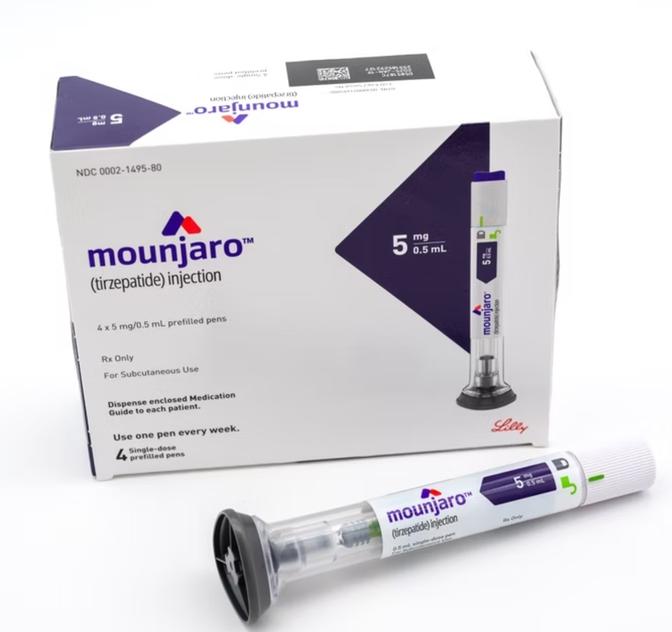Can Mounjaro Injection Transform Your Health? Exploring Its Impact on Diabetes

Can Mounjaro Injection Transform Your Health? Exploring Its Impact on Diabetes
Managing type 2 diabetes can be a lifelong challenge, requiring careful attention to blood sugar levels, diet, and lifestyle. In recent years, Mounjaro Injection (tirzepatide), a groundbreaking injectable medication, has emerged as a game-changer for people with type 2 diabetes. Beyond its primary role in blood sugar control, Mounjaro has also shown remarkable potential for weight loss, making it a dual-action treatment that’s generating buzz in the medical community. But can Mounjaro truly transform your health? In this blog, we dive into how Mounjaro works, its benefits for diabetes management, its secondary effects on weight, and key considerations to determine if it’s right for you. Always consult a healthcare provider before starting any new medication.
What Is Mounjaro?
Mounjaro, developed by Eli Lilly, is a once-weekly injectable medication approved by the FDA in 2022 for adults with type 2 diabetes. Its active ingredient, tirzepatide, is a dual glucose-dependent insulinotropic polypeptide (GIP) and glucagon-like peptide-1 (GLP-1) receptor agonist. This unique mechanism sets Mounjaro apart from other diabetes medications, as it mimics two hormones that regulate blood sugar and appetite, offering a powerful approach to managing diabetes and related health challenges.
Mounjaro is primarily prescribed to improve glycemic control in adults with type 2 diabetes, alongside diet and exercise. It’s not approved for type 1 diabetes or for use in children. Additionally, its significant weight loss effects have made it a popular off-label option for obesity management, though this use requires careful medical supervision.
How Does Mounjaro Work?
Mounjaro’s dual GIP and GLP-1 receptor agonist action targets multiple pathways in the body to manage type 2 diabetes effectively:
-
Enhances Insulin Secretion: Mounjaro stimulates the pancreas to release insulin when blood sugar levels are high, helping to lower glucose levels after meals.
-
Reduces Glucagon Production: It suppresses glucagon, a hormone that prompts the liver to release stored glucose, preventing unnecessary spikes in blood sugar.
-
Slows Gastric Emptying: By slowing the rate at which food leaves the stomach, Mounjaro reduces post-meal blood sugar spikes and promotes a feeling of fullness.
-
Improves Insulin Sensitivity: The GIP component enhances the body’s response to insulin, making cells more efficient at absorbing glucose.
These actions work together to lower hemoglobin A1c (HbA1c), a key marker of long-term blood sugar control. Additionally, Mounjaro’s effects on appetite regulation and metabolism contribute to significant weight loss, which can further improve diabetes outcomes.
Key Benefits of Mounjaro for Diabetes
Mounjaro has quickly gained attention for its impressive efficacy and multifaceted benefits. Here are the primary ways it can transform health for people with type 2 diabetes:
1. Superior Blood Sugar Control
Clinical trials, such as the SURPASS program, have shown that Mounjaro significantly reduces HbA1c levels. In these studies, patients taking Mounjaro (5 mg, 10 mg, or 15 mg doses) achieved HbA1c reductions of 1.8% to 2.4% after 40–52 weeks, compared to 0.5% to 1.5% for other diabetes medications like semaglutide or insulin glargine. Many participants reached HbA1c levels below 7%, the target for most adults with diabetes, indicating excellent glycemic control. This makes Mounjaro a powerful tool for managing blood sugar and reducing the risk of diabetes-related complications, such as kidney disease, nerve damage, and cardiovascular issues.
2. Significant Weight Loss Benefits
One of Mounjaro’s standout features is its ability to promote substantial weight loss, which is particularly beneficial for people with type 2 diabetes, as excess weight can worsen insulin resistance. In clinical trials, patients lost an average of 12–25 pounds (5.5–11.3 kg) over 40–52 weeks, with higher doses (15 mg) yielding up to 20% body weight reduction in some cases. This weight loss not only improves diabetes control but also reduces the risk of obesity-related conditions like hypertension and heart disease. For many, this dual benefit enhances overall health and quality of life.
3. Once-Weekly Convenience
Unlike some diabetes medications that require daily dosing, Mounjaro is administered once a week via a subcutaneous injection using a pre-filled pen. This convenient dosing schedule improves adherence, making it easier for patients to stick to their treatment plan. The injection is typically given in the abdomen, thigh, or upper arm, and most users find it simple to self-administer after proper training.
4. Cardiovascular Health Benefits
Type 2 diabetes increases the risk of cardiovascular diseases, such as heart attack and stroke. While Mounjaro’s primary approval is for glycemic control, its weight loss and metabolic effects may contribute to improved cardiovascular outcomes. In trials, Mounjaro reduced risk factors like high cholesterol and blood pressure, which are critical for heart health. Ongoing studies are exploring its long-term cardiovascular benefits, but early data is promising.
5. Potential to Reduce Medication Burden
For some patients, Mounjaro’s potency allows for better diabetes control with fewer additional medications. In clinical trials, patients on Mounjaro often required less insulin or other glucose-lowering drugs compared to those on standard treatments. This can simplify treatment regimens, reduce costs, and lower the risk of side effects from multiple medications.
Potential Side Effects and Risks
While Mounjaro offers significant benefits, it’s not without potential downsides. Common side effects include:
-
Nausea
-
Diarrhea
-
Vomiting
-
Decreased appetite
-
Constipation
-
Abdominal pain
These side effects are usually mild to moderate and tend to decrease over time as the body adjusts. Starting with a low dose (e.g., 2.5 mg) and gradually increasing helps minimize discomfort.
Serious but rare risks include:
-
Pancreatitis: Symptoms like severe abdominal pain, nausea, or vomiting require immediate medical attention.
-
Gallbladder Issues: Gallstones or cholecystitis have been reported in some patients.
-
Hypoglycemia: Low blood sugar is more likely when Mounjaro is combined with insulin or sulfonylureas.
-
Thyroid Tumors: Animal studies showed a risk of thyroid C-cell tumors, so Mounjaro is not recommended for those with a personal or family history of medullary thyroid carcinoma or multiple endocrine neoplasia syndrome type 2 (MEN 2).
-
Kidney Effects: Dehydration from gastrointestinal side effects can stress the kidneys, particularly in those with pre-existing kidney issues.
Mounjaro is not suitable for everyone, including those with type 1 diabetes, severe gastrointestinal disorders, or certain endocrine conditions. Always discuss your medical history with your doctor to ensure Mounjaro is safe for you.

Is Mounjaro Right for You?
Mounjaro may be a transformative option if:
-
You have type 2 diabetes and struggle to achieve HbA1c targets with current treatments.
-
You’re overweight or obese, as Mounjaro’s weight loss effects can enhance diabetes management.
-
You prefer a once-weekly injection over daily medications.
-
Your doctor confirms you have no contraindications, such as a history of thyroid cancer or severe gastrointestinal issues.
Mounjaro may not be suitable if:
-
You have type 1 diabetes or diabetic ketoacidosis.
-
You have a history of pancreatitis, thyroid cancer, or MEN 2.
-
You experience intolerable gastrointestinal side effects.
-
You’re pregnant, breastfeeding, or planning to become pregnant, as safety data is limited.
Key Considerations
-
Medical Supervision: Work closely with your doctor to determine the right dose and monitor for side effects. Regular blood tests can track HbA1c and kidney function.
-
Lifestyle Support: Mounjaro works best alongside a healthy diet and regular exercise. A nutritionist or diabetes educator can help optimize your plan.
-
Cost and Access: Mounjaro can be expensive without insurance coverage, so check with your provider about costs and alternatives like patient assistance programs.
-
Gradual Dosing: Starting at a low dose (2.5 mg) and titrating up every 4 weeks minimizes side effects and improves tolerability.
Alternatives to Mounjaro
If Mounjaro isn’t suitable, other type 2 diabetes treatments include:
-
GLP-1 Agonists: Semaglutide (Ozempic, Wegovy) or dulaglutide (Trulicity) offer similar benefits but target only GLP-1 receptors.
-
Metformin: A first-line oral medication for blood sugar control.
-
SGLT2 Inhibitors: Drugs like empagliflozin (Jardiance) lower blood sugar by increasing glucose excretion in urine.
-
Insulin Therapy: For advanced diabetes, insulin may be necessary.
-
Lifestyle Interventions: Diet, exercise, and weight loss can significantly improve diabetes control.
Discuss options with your doctor to find the best fit for your health goals.
Conclusion
Mounjaro has the potential to transform the health of people with type 2 diabetes by offering superior blood sugar control, significant weight loss, and a convenient once-weekly dosing schedule. Its dual GIP and GLP-1 action sets it apart from other medications, delivering powerful results that can reduce diabetes-related complications and improve quality of life. For many, its weight loss benefits are a game-changer, addressing a key driver of insulin resistance.



